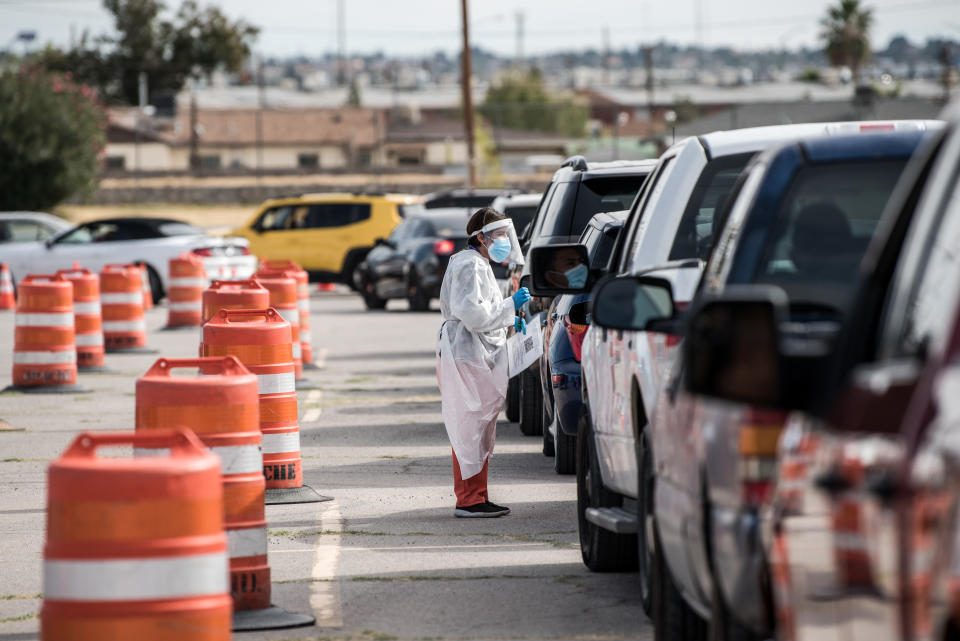Don't know how you contracted COVID-19? Experts say 'it's no longer obvious'
Across the country, cases of COVID-19 are increasing at an alarming pace. In the last seven days, more than 500,000 people were diagnosed with COVID-19, according to the Centers for Disease Control and Prevention. And a growing number of people have no idea how they contracted the virus, doctors say.
“It’s increasingly becoming common” for patients to not know how they got COVID-19, Dr. Amesh A. Adalja, a senior scholar at the Johns Hopkins Center for Health Security, tells Yahoo Life. Dr. Richard Watkins, an infectious disease physician and professor of internal medicine at the Northeast Ohio Medical University, agrees. He tells Yahoo Life that “lately, most of” his patients don’t know where they contracted the virus. The same is true for Dr. Rajeev Fernando, an infectious disease expert in Southampton, N.Y. For many of his patients, “it’s because people tell me they’ve not been wearing masks as they should,” he tells Yahoo Life.
This trend says a lot about the virus and where things are headed, Dr. William Schaffner, an infectious disease specialist and professor at the Vanderbilt University School of Medicine, tells Yahoo Life. “The virus can spread from people who have no symptoms or who are asymptomatic,” he says. “It’s now spreading in a way that people experience when they get the common cold. They wonder, ‘Where did I get that?’ and it can be difficult to really know the answer. This is an indication of how widely spread the virus has become in our communities.”

Henry F. Raymond, associate professor and epidemiologist at the Rutgers School of Public Health, tells Yahoo Life that the increase in people who don’t know how they contracted COVID-19 indicates that “there are a lot of asymptomatic spreaders.”
“It’s no longer obvious, like you were with a friend, they looked bad and they sneezed on you,” he says. “We’re definitely seeing a lot of younger people who are asymptomatic, carrying the virus and spreading it.”
At the same time, “many people don’t understand how contagious the coronavirus is,” Watkins says, adding, “this, combined with the high number of asymptomatic infected people, is what is driving the pandemic, which is not showing signs of slowing. We are definitely not ‘turning a corner.’”
Not knowing how you caught the virus can make it difficult for contact tracers to figure out patterns in transmission, Raymond says. It’s not entirely cut and dry, though.
“In some ways it’s easier, in some ways it’s harder,” Adalja says. “If you don’t know who you got the virus from, it’s hard to find patterns with contact tracing.” But people are increasingly spending time in smaller groups, which can make it easier for contact tracers to know who to contact next, he says. “If you have only been around three people, it’s easier to know who are your contacts,” Adalja says.
The rise of contact tracing apps like New York’s COVID Alert NY and Pennsylvania’s COVID Alert PA may help, but it’s too soon to know how much they can contribute, Raymond says. “It’s too early to tell how many people are actually going to download them and activate them to see what impact it might have,” he says.
The trend toward people hosting others in their own homes as the weather cools is concerning to Adalja. “It’s harder to intervene in what people are doing in their own homes versus in mass gatherings or at a restaurant. It’s much more difficult to come up with a plan for people to follow.”
That’s why Adalja recommends that people remain “really vigilant” about how they’re acting when they’re around others. In addition to following the CDC’s guidelines for preventing the spread of the virus, like wearing masks, practicing social distancing and washing hands regularly, Adalja urges people to think about their potential exposure at home. “If you can see other people outdoors instead of indoors and keep your distance, that’s better,” he says. “I suspect that people are not going to be wearing face coverings in their own home.”
Raymond stresses that people should be aware that current case counts of the virus are “just the tip of the iceberg,” adding, “in general, the amount of virus in the community is much higher than people realize.” There are “probably thousands who are, on some level of the spectrum — maybe they feel achy but they don’t get a test, or they don’t feel bad at all but they’re spreading the virus — and they’re not being counted,” Raymond says.
Raymond urges people to be aware that the pandemic is still ongoing, and that it’s getting worse. “We are in this for a longer time than we ever hoped,” he says. “Now is not the time to think that the fight is over.”
For the latest coronavirus news and updates, follow along at https://news.yahoo.com/coronavirus. According to experts, people over 60 and those who are immunocompromised continue to be the most at risk. If you have questions, please reference the CDC’s and WHO’s resource guides.
How to maintain your physical and mental health during the pandemic
Taking care of a loved one with COVID-19? Here’s how to stay healthy
Q&A with Dr. Kavita Patel: How to keep your family safe and maintain your mental health
Read more from Yahoo Life
Study finds brain abnormalities 'common' in COVID-19 patients
'COVID toes' may persist for months in long-haulers, study finds
Want lifestyle and wellness news delivered to your inbox? Sign up here for Yahoo Life’s newsletter.




